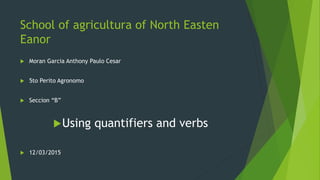This document contains summaries and examples of English grammar concepts such as the present perfect of "there is/are", future tense of "have to", introduction to the passive voice, past perfect tense with "yet/already", quantifiers, "must/might", past simple of "can", reported speech, modal verbs like "can", "mustn't", and "have to". Each concept includes a brief definition or explanation followed by examples to illustrate usage. Websites for further reading on English grammar are also provided.



















